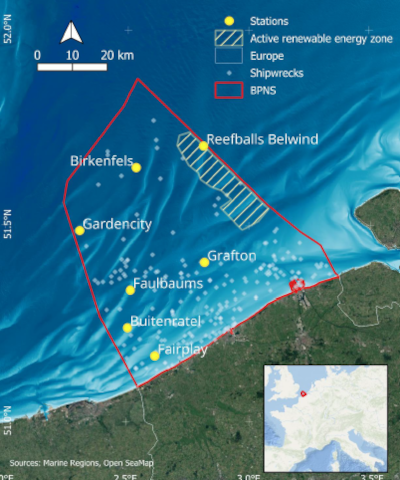Why?
Underwater soundscapes have cultural, ecological and economic value. Sound recordings can be used to increase Ocean Literacy and environmental awareness. A better understanding of the ocean can help to resolve effectively critical environmental challenges and support measures required for marine conservation and sustainable development and exploitation. Anthropogenic influences on soundscapes, e.g. noise caused by large ships, can cause the loss of habitat, interfere with the acoustic communication among marine animals, or reduce the chances of recruitment for restoration plans. Therefore, soundscapes have also an economic value for fisheries, ecosystem functioning and coastal protection. To mitigate the effects of noise pollution on marine life, it is necessary to understand and report these soundscapes in a quantifiable way for policymakers. Characterizing the individual sound events contributing to the underwater soundscape is a work of endurance and especially in more coastal, turbid areas, it is challenging to define the source of each detected sound.
The goal of the underwater sound library is to collect and curate a wide range of underwater sound events that occur within the marine ecosystem, and to make these recordings publicly accessible. By inviting the public to listen to these diverse and often unknown soundscapes and sound events, the project seeks to raise awareness about the rich acoustic environment of the ocean and its ecological significance. For policymakers, the library offers an opportunity to become more familiar with the variety and role of underwater sounds, fostering more informed decisions regarding ocean health and noise pollution. Additionally, the platform aims to promote international scientific collaboration by providing a shared space where researchers can both contribute and access underwater recordings. The library of sounds can support the development of automatic models to detect and classify these sounds, which would help advance our understanding of the marine soundscape, its biological and physical components, and the impacts of human activity on this complex acoustic environment.
For researchers, this library is an opportunity to share and compare different sounds in a structured way. This is important because underwater sounds are still a large unknown, and very few sounds can confidently be assigned to a certain producer (species). Soundlib provides the framework to work across institutes to reduce this knowledge gap.
What?
Sound is a vibration that propagates as an acoustic wave through a transmission medium such as air or water. Sounds are commonly described as they are perceived, e.g. loud or soft, high-pitched or low-pitched. Scientists describe sounds using characteristics that can be measured with instruments, such as intensity, frequency, and duration. Intensity can be related to the volume of the sound and is measured in decibels (dB), whereas frequency can be related to a perceived pitch and is measured in Hertz (Hz).
The natural soundscape of the ocean is a dynamic environment made up of natural biotic and abiotic sounds. Biotic sounds include the calls of whales, the whistles of dolphins, the grunts of fish, the crabs’ stridulations, etc. Sounds of marine animals are used to communicate, forage, mate, or avoid predators, amongst others. Abiotic sounds of the ocean include, for example waves, underwater volcanoes, or cracking ice. The ability to produce and receive sounds is vital for the survival of marine animals. Anthropogenic activities also contribute to the soundscape and can therefore have an effect on the marine fauna. Understanding these impacts can be tackled in various ways: quantifying the added decibels to the system, studying the physiological and behavioural effects of certain sounds on the fauna or increasing our understanding of how animals use sound in their life cycle.
For more information about underwater sound and soundscapes, please visit the Dosits website.
How was the current data collected?
Underwater sound is collected with hydrophones, which are devices very similar to microphones but which can go underwater. For more information, please visit How is sound measured.
Data currently (2025) available in this library was collected in the Belgian part of the North Sea (BPNS), mainly in the framework of the LifeWatch project. A broadband acoustic network was set up with the aim to collect (semi-)continuous acoustic data at several locations to capture long term trends, seasonal, lunar and diel patterns as well as spatial patterns. All stations were located close to shipwrecks as shipwrecks are generally biodiversity hotspots in the BPNS and usually avoided by trawling fishing boats. In this context, a deployment is defined as a measuring interval corresponding to the time when a hydrophone is in the water without changing the recording parameters. The hydrophone is fixed in vertical position to a bottom moored lander designed by VLIZ at 1m above the sea floor. The use of such mooring for scientific purposes and all the linked projects can be seen here.

Stations of LifeWatch Broadband Acoustic Network in BPNS
How can researchers contribute?
In the future, SoundLib will be open to researchers around the world who want to contribute their data. The database will link to the raw data and depending on the chosen licence will show the long term trends on the library. Contributing with long-term sound recordings will enhance comparability between different recording sites. On the other hand, contributing with specific sound events will allow us to identify similarities and differences between sounds from different places, increasing the chances of discovering who makes what sound. To explore this functionality, visit the similarity plot of the selected sound events.
Are you a scientist interested in contributing your data? Please get in touch with us at passiveacoustics@vliz.be!